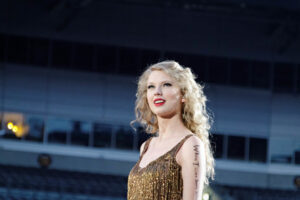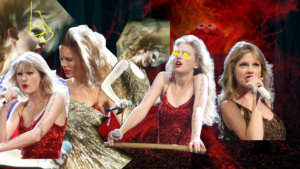“[I] just remembered she’s a millennial,” joked one TikTok user in a video that got nearly 100,000 likes. The video, a duet of Taylor Swift’s first Tiktok in mid-August, was indicative of the amused surprise with which Swift’s fans welcomed her into the weird and wonderful world of TikTok. A comment on Swift’s video affectionately referred to her as a “Facebook mom” due to the cheesy filters and transitions she used while lip syncing to “Screwface Capital” by Dave. Over the next few weeks, Swift eased into the fast-moving trends on Tiktok, promoted the release of her upcoming album, Red (Taylor’s Version), and began posting the earnest and (sometimes unintentionally) funny content, plus cat videos, that have long characterized her presence on social media.
But then, on September 17, Swift flipped the script; she announced, out of the blue, the release of “Wildest Dreams (Taylor’s Version)” off her album 1989 in response to a trend gaining traction on Tiktok using an audio from the song. The surprise announcement seemingly threw off her Red (Taylor’s Version) album release timeline by giving fans a taste of another beloved era. Suddenly, rather than a dorky millennial trying to figure out how to use TikTok, Swift was in control of her platform and using the app to inform savvy promotional decisions. Yet fans really shouldn’t have been surprised. After all, a defining aspect of Swift’s long career has been her ability to harness the power of social media to control her narrative—and her use of TikTok is no exception. In the late 2000s, Swift relied on platforms like MySpace and Tumblr to connect with fans during her ascent to the top of the music industry, and since then, she’s used social media to maintain this position. Within this context, even after Swift’s withdrawal from the Internet over the past few years, her recent embrace of TikTok and “surprise” drop of “Wildest Dreams (Taylor’s Version)” is just a continuation of her ever-evolving relationship with social media.
Swift released her self-titled debut album in 2006. At the time, like many of her fellow 16-year-olds, she posted frequently on MySpace, from prom pictures and Photo Booth selfies to precursive subtweets directed at anonymous boys. As she transitioned to life as a public figure, she embraced MySpace and Tumblr as ways to connect on a personal level with her audience, defining her brand as the relatable girl-next-door and friendly big sister to her dedicated stans, whom she began calling Swifties. She offered reassuring words to heartbroken fans and responded to memes with self-aware humor. On Youtube, Swift made casual, short vlogs documenting everything from life on tour to goofy moments with Selena Gomez and even a dentist appointment to get a new retainer. From the beginning of her career, Swift used social media to speak directly with her largely teenage audience and craft an image centered around authenticity, which intersected naturally with her honest, confessional songwriting tendencies.
As her career blossomed, Swift catered her content to each platform, engaging in individual conversations with her most dedicated fans on Twitter and Tumblr while using other platforms as more general public pages. She relied increasingly on Instagram to share pictures from her famous celebrity-filled 4th of July parties and photoshoots for magazine covers and screenshots from text conversations with Ed Sheeran. In the leadup to album releases, Swift personally reached out to fans on social media to invite them to “Secret Sessions,” special album listening parties she hosted at each of her homes across the country. Having arrived at the top of the pop music game, Swift continued to use social media to maintain her accessible image, but also deftly incorporated more curated, promotional content, such as music video teasers and “easter eggs,” subtle clues about new projects for her eagle-eyed fans to interpret.
The year 2016 was characterized by a redefinition of Swift’s relationship with social media and the public at large. Following the fallout from her very public feud with Kanye West, she essentially withdrew from the public eye, clearing her social media feeds and physically going into hiding. When she made her return to the Internet in 2017 with her album reputation, her social media had lost its personal feel; instead of near-daily seemingly random and organic posts, Swift now posted either strategic, heavily planned content accompanying the release of music videos and singles, or professional photography from tour. This new approach aligned with the overall withdrawn and detached tone of her reputation era; in announcing the album, Swift cryptically captioned an Instagram post “there will be no further explanation. There will just be reputation.” Beyond the Kanye beef, Swift faced other crises; when the rights to her master recordings were sold to industry executive Scooter Braun, whom Swift characterized as an “incessant, manipulative bully,” she vowed to re-record that body of work and release “Taylor’s Version” of each of her first six albums. Amid public conflicts and the subsequent intense media speculation, Swift’s post-2016 social media never quite attained the level of intimacy she had created in the early years of her career.
Thus, especially for newer fans who hadn’t experienced her pre-reputation PR strategy, her active, lighthearted use of TikTok appeared to be a departure from expectations. From jokes at her own expense to cat content to countless comments on fans’ videos to easter eggs, in a few short weeks, Swift demonstrated all the hallmarks of the “Old Taylor” approach to social media. In this way, Swift’s masterful use of social media allowed her to forge a relationship with a new generation of fans, just as she had done as a teenager. Yet with the TikTok-induced release of “Wildest Dreams (Taylor’s Version),” Swift also demonstrated her keen awareness of trends and her ability to take advantage of them. Ultimately, many singers use social media effectively to further their careers: Lil Nas X strategically uses humor and controversy to generate buzz around his releases, and Kelsea Ballerini’s raw and sometimes rambling Instagram stories allow fans to feel like they’re chatting with a friend on FaceTime. However, Swift has distinguished herself throughout her career through her ability to combine the two styles, resulting in a savvy, deliberate social media presence that simultaneously feels authentic and personal—and TikTok seems to be her new frontier.





